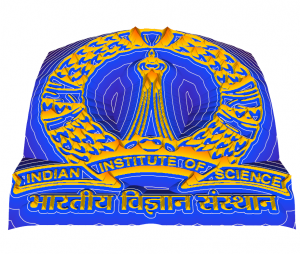IISc Research Insignia
This page features the IISc logo or the abbreviation “IISc” used to exemplify an algorithm, a concept, a discovery, a design, an invention, a process, or any other scientific, engineering, or technological research done in IISc.
Landscaping IISc Logo

The IISc logo landscape was created by computing a topology-based segmentation of a signed distance field. The figures below illustrates the different steps in creating the landscape. The IISc logo was first converted to a binary image by applying a thresholding filter. Next, a collection of boundary curves was extracted from the binary image. A clean signed distance field from the set of curves was computed over a unit square. The sign of the distance field essentially segments the image into the blue and golden regions. The distance field is mapped to elevation resulting in a terrain, the IISc logo landscape. Isocontours of the distance field are computed and displayed over the terrain to highlight the valleys. Further details, including a video illustrating the mapping from the signed distance field to the terrain, are available @ http://vgl.csa.iisc.ac.in/iiscLogo/
References:
Parallel computation of 2D Morse-Smale complexes.
Nithin Shivashankar, Senthilnathan M and Vijay Natarajan.
IEEE Transactions on Visualization and Graphics, 18(10), 2012, 1757-1770. (pdf)
Parallel computation of 3D Morse-Smale complexes.
Nithin Shivashankar and Vijay Natarajan.
Computer Graphics Forum (EuroVis 2012), 31(3), 2012, 965-974 (pdf)
Efficient software for programmable visual analysis using Morse-Smale complexes.
Nithin Shivashankar and Vijay Natarajan.
Topological Methods in Data Analysis and Visualization IV.
Hamish Carr, Christoph Garth, and Tino Weinkauf (Eds.)
Springer-Verlag, Mathematics and Visualization Series, 2016, to appear.
http://vgl.csa.iisc.ac.in/pub/paper.php?pid=052
Other Featured research




